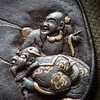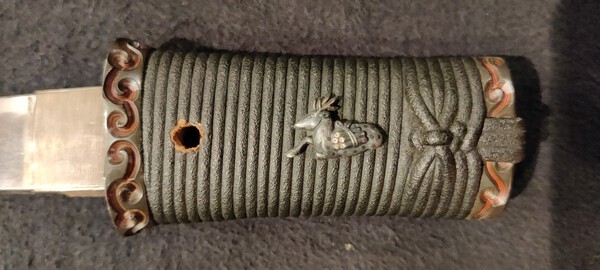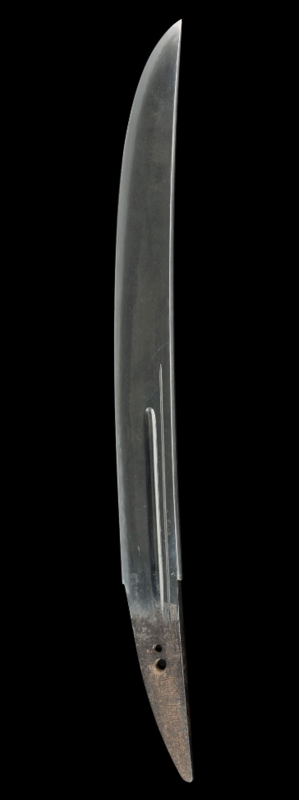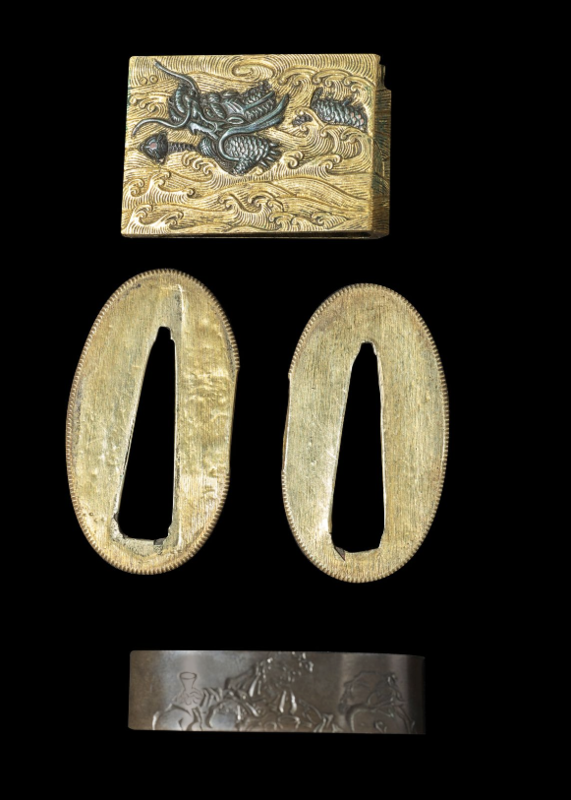-
Posts
395 -
Joined
-
Last visited
Content Type
Profiles
Forums
Events
Store
Downloads
Gallery
Posts posted by francois2605
-
-
-
7 hours ago, Michaelr said:
I have a Nagamitsu sword dated May 1945 and was wondering how rare/ unusual it is to have a blade dated May 1945 since WW2 ended in May 45. Just thought this was interesting. Thank you in advance. MikeR
Well... the WW2 ended in May 1945 in Europe, not in Asia. Your sword was crafted 3 months before the end of the WW2 which happened on Sept, 2nd in Japan.
-
 1
1
-
-
Well I didn't because the price was very reasonable, I must be the exception
-
-
Yes. From Sesko's excellent encyclopedia of Japanese swords:
Quotechikei (地景) – Lit. “shadow(s) in the steel.” A black gleaming line of nie in the ji, i.e. of ji-nie. Chikei are an effect of hardening and not limited to follow the layer structure of the jihada and are basically the same as kinsuji but appearing in the ji. But in the case of a steel-mix of steels with different carbon content, for example like used by the Sōshū smiths, the darker layers of jihada are also described as chikei. In other words, we have two kinds of chikei: Such going back to hardening, and such going back to the forging structure or rather the layers of the steel.
-
-
Very nice, the difference between your first 2 shots is like night and day !
-
 1
1
-
 1
1
-
-
I find it too difficult to shoot a sword with direct lightning.
Instead I shoot when the sword is lit by the (preferably low) ambiant light to avoid very high contrasts. This also requires a very long exposure (10+ secs), low ISO (to avoid noise), a tripod and a remote (or 2-sec delay).
I believe that the end result better shows the hataraki in those conditions. Here's an example (edited in Lightroom).
-
 4
4
-
 2
2
-
-
Steve, just a friendly advice: don't buy anything off eBay unless you know exactly what you're buying.
The fact that you "were on the fence", don't know that a gendaito stands for "traditionally made from tamahagane", can't visually differentiate between a showato and gendaito probably means that you should read more about the topic before making another purchase.
There was zero risk with this purchase: Eric is a honest and trusted seller, the sword is legit.
Again, this is just a friendly advice to ensure you spend your money wisely and with confidence.
-
 4
4
-
-
So excited by the upcoming sales and book. I feel like a kid at Xmas
-
This is just awful, the worst being that the offender seems very happy with the end result.
-
15 hours ago, Swords said:
Thanks Brian that’s good to hear Im still not Sure what makes a million yen two million etc
Steve,
You can read more about the different ways of rating swordsmiths here.
I personally don't pay too much attention to "1 million vs 2 million" comparisons, the value is not absolute: you'll see that some swordsmiths are rated high by someone and low by someone else. Of course it's better if your sword is signed by a highly rated smith but that's a plus, the sword should be considered on its own merits first.
-
 1
1
-
-
-
Eric Molinier is a super nice french guy from New-York and always very honest when describing items. I consider him one of the most trustworthy sellers of nihonto on eBay. His swords are among the best you can get via eBay.
-
 2
2
-
-
Since someone mentioned the Evangelion sword exhibition, here are some pictures I shot in 2014 while the exhibition was in Paris.
-
 3
3
-
 1
1
-
-
That was my plan, thanks Barry
 I already sent him an email.
I already sent him an email.
-
OK, that's what I thought. Will find another way to get what I what.
Thanks very much, Jon
-
 1
1
-
-
Do you know if the website https://www.kusanaginosya.com/ accepts selling to foreign customers ? I checked their website and couldn't find any information about this which makes me think they only accept sales to local customers. Has anyone from NMB already bought from this dealer ?
Thanks very much.
-
Grev, the Dropbox link is dead FYI: it says the file has been deleted
-
Yes, this page provides some information about such cutting tests.
Out of curiosity, can you please provide pictures of the sword itself ?
-
-
-
6 hours ago, robinalexander said:
Hi Neil, always going to be out of my price range but maybe you could post a couple of pics on the 'Show us your high class gunto' thread?
Rob
He already did here:
I had found a PDF on the Unique Japan website describing a sword exactly similar to his: https://new.uniquejapan.com/wp-content/uploads/2019/12/ujka363-Gassan-Sadakatsu-Crown-Prince-Akihito-Ayasugi-Katana-Description.pdf
-
 1
1
-
-
Yes, it's this sword visible here (on auction tomorrow): https://www.drouotonline.com/l/15882162--shinto-wakizashiepoque-edo-16?actionParam=listLot&controllerParam=lot&fromId=116199
Copying the description below to preserve it.
QuoteShinto wakizashi
Epoque EDO (1603 - 1868)
Signé (mei) : Kunishige
Lame (sugata) : hira zukuri, mitsu mune, bo hi ni tsure hi, un horimono bonji mato kannon sur une face
Motif de forge (hada) : mokume
Trempe (hamon) : hotsure suguha
Pointe (boshi) : o-maru
Fusée (nakago) : ubu keitai, haagari nakagojiri, deux mekugi ana, katte sagari yasurime
Longueur (nagasa) : 35,3 cm
Monture (koshira-e) :
Tsuba fuchi kashira : en suite en shibuichi à décor en katakiri bori des sept sages dans la forêt de bambou. Tsuba et fuchi signés Godai Kiryusai Somin suivi de kao. (Ecole Yokoya, 5e génération)
Kogatana : kozuka en shibuichi et cuivre doré à décor en relief d'un motif kurikara ken ryu (dragon sur un ken), sur fond nanako, le revers à motif dit neko yasuri (griffures de chat), Ecole Goto. La lame ornée d'un bonji et signée Katsuren
Habaki : en cuivre doré et shakudo ciselé d'un dragon parmi les vagues tenant le tama
Kurikata : en shibuichi à motif nanako orné d'un môn daki myo ga (pousses de gingembre), utilisé par la famille Hori de Iida
Menuki : en cuivre doré figurant deux dragons
Fourreau (saya) : en laque alternant des rayures noires ro-iro et des rayures noires à inclusion de fines lamelles de bois, orné de deux môn en cuivre doré : daki myo ga (pousse de gingembre) et ageha no cho (papillon)
Provenance : vente Collection Bakhmeteff, Mes Lair Dubreuil et Bellier, Drouot, 16-18 janvier 1929
Le fondateur de l'école Yokoya, Somin, de son vrai nom Yokoya Chojiro, (1670-1733) avait étudié la la peinture de l'école Kano, et est l'inventeur de la technique du katakiri bori, qui imite des traits de pinceau dans le métal.
Adding some pictures too.
















My first sword: Noshu Ju Marayama Kaneshige Saku
in Military Swords of Japan
Posted
Just found the original pictures from this WAF thread (from BenVK): source